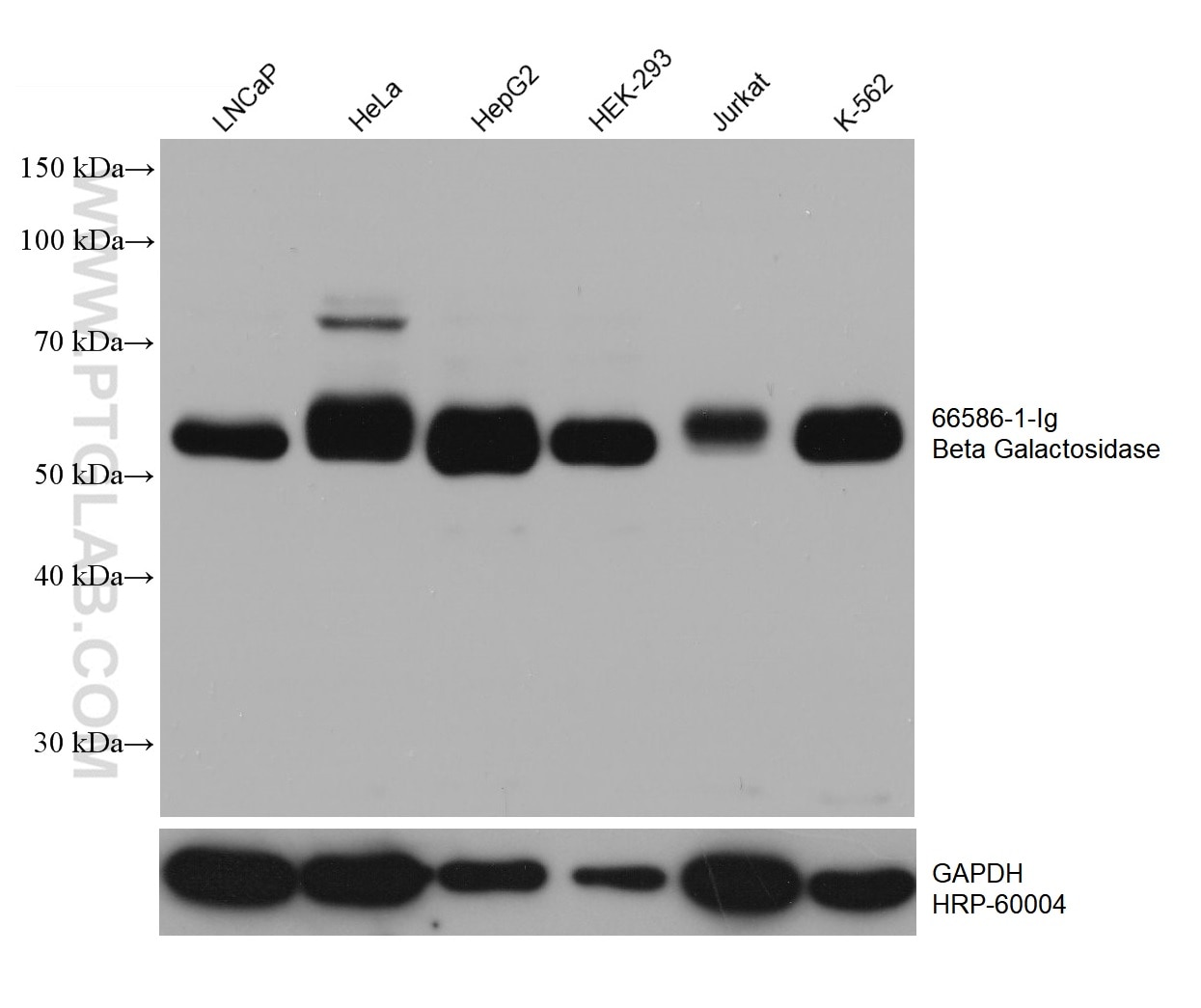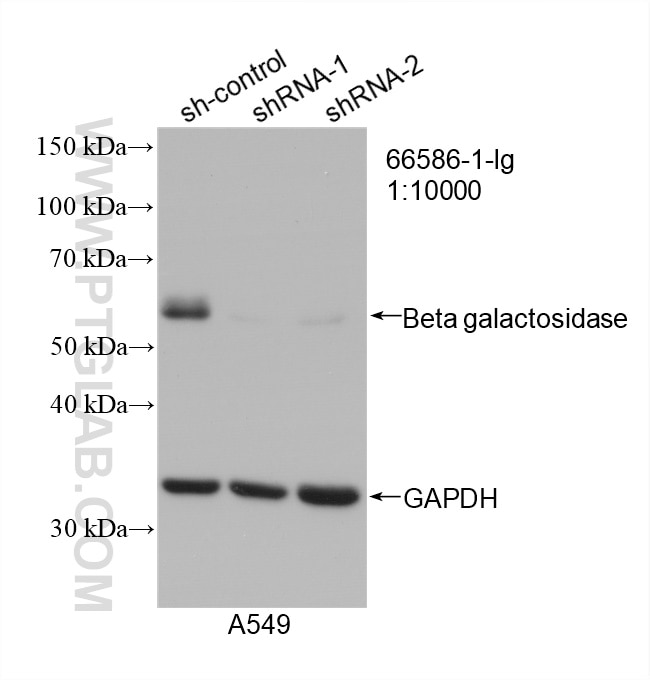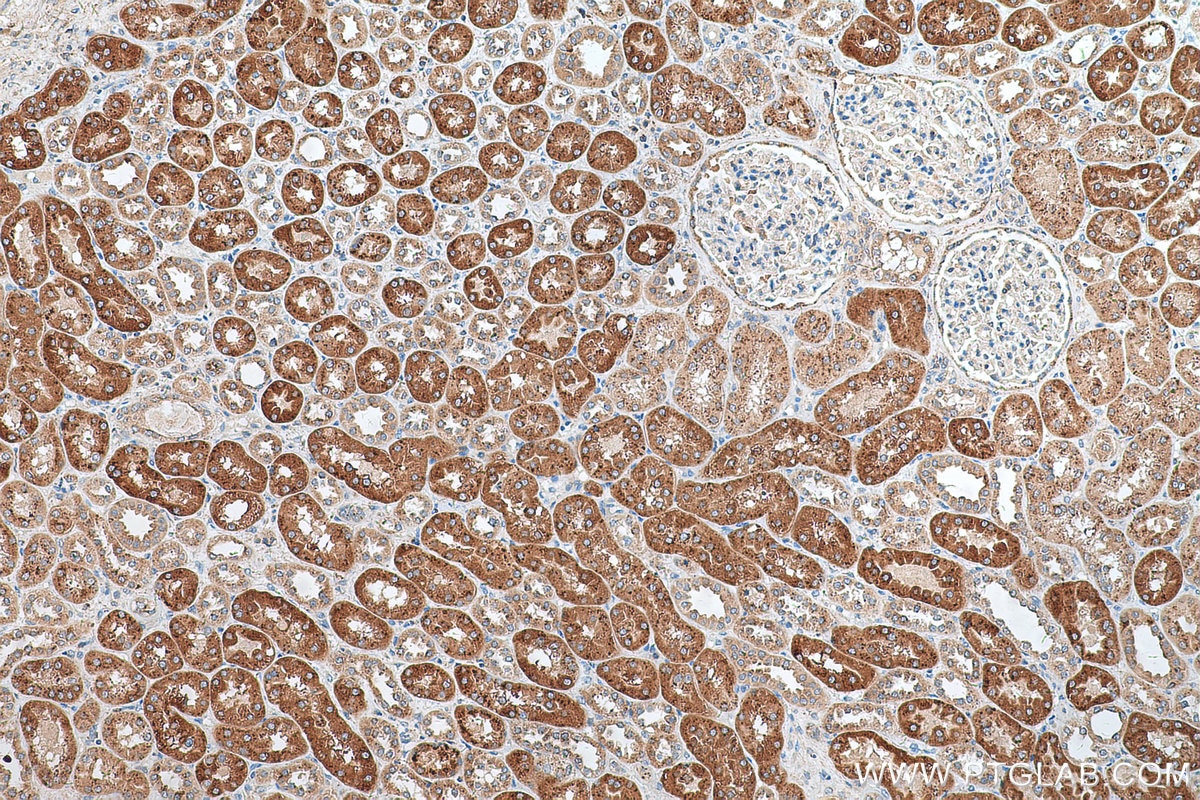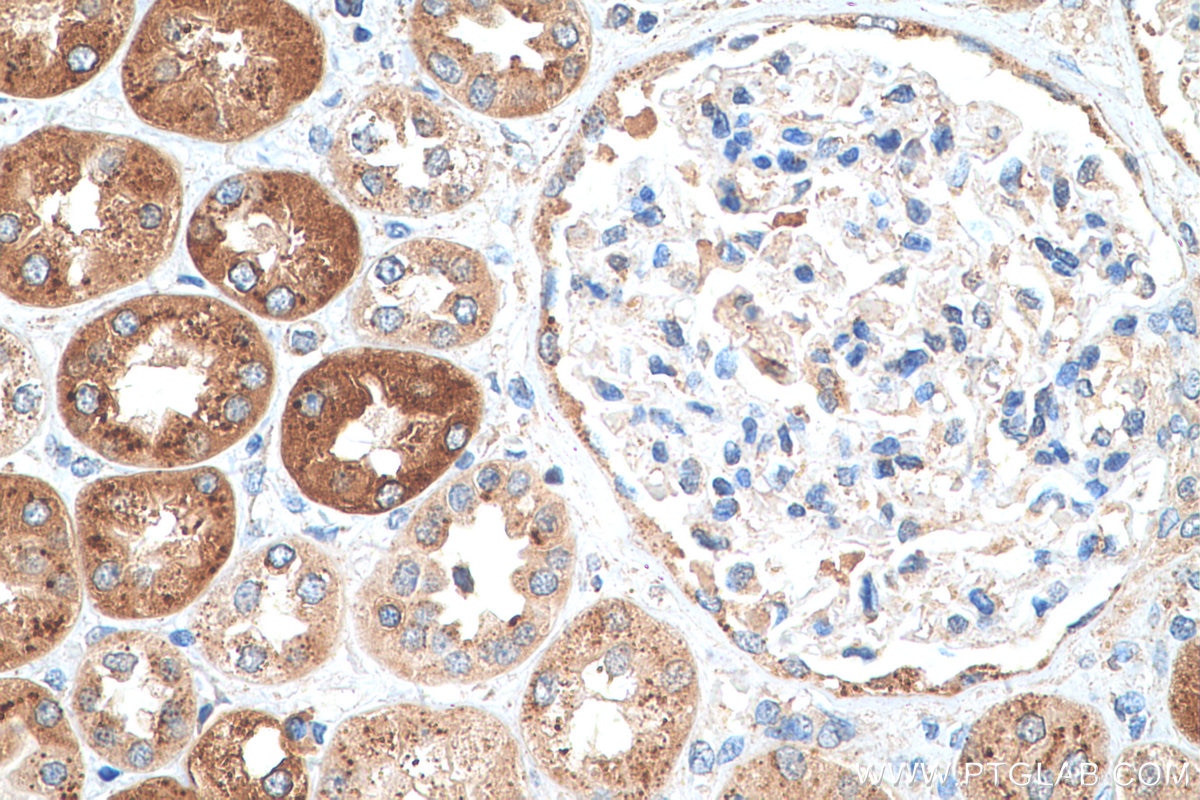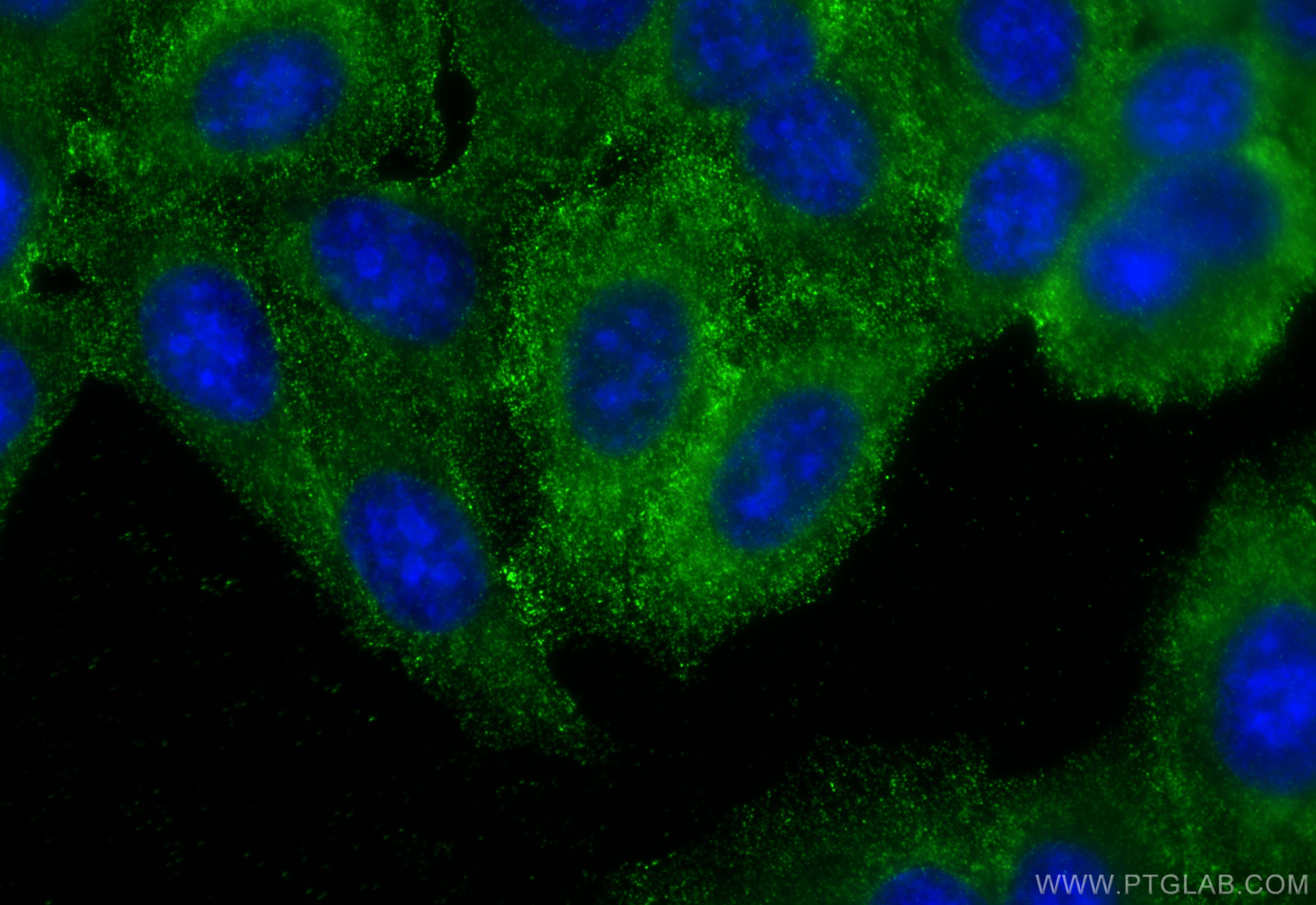- Featured Product
- KD/KO Validated
Beta Galactosidase Monoklonaler Antikörper
Beta Galactosidase Monoklonal Antikörper für WB, IHC, IF/ICC, ELISA
Wirt / Isotyp
Maus / IgG1
Getestete Reaktivität
human, Maus, Ratte und mehr (1)
Anwendung
WB, IHC, IF/ICC, ELISA
Konjugation
Unkonjugiert
CloneNo.
4F4F4
Kat-Nr. : 66586-1-Ig
Synonyme
Geprüfte Anwendungen
| Erfolgreiche Detektion in WB | LNCaP-Zellen, A549-Zellen, HEK-293-Zellen, HeLa-Zellen, HepG2-Zellen, Jurkat-Zellen, K-562-Zellen |
| Erfolgreiche Detektion in IHC | humanes Nierengewebe Hinweis: Antigendemaskierung mit TE-Puffer pH 9,0 empfohlen. (*) Wahlweise kann die Antigendemaskierung auch mit Citratpuffer pH 6,0 erfolgen. |
| Erfolgreiche Detektion in IF/ICC | HepG2-Zellen |
Empfohlene Verdünnung
| Anwendung | Verdünnung |
|---|---|
| Western Blot (WB) | WB : 1:5000-1:50000 |
| Immunhistochemie (IHC) | IHC : 1:250-1:1000 |
| Immunfluoreszenz (IF)/ICC | IF/ICC : 1:200-1:800 |
| It is recommended that this reagent should be titrated in each testing system to obtain optimal results. | |
| Sample-dependent, check data in validation data gallery | |
Veröffentlichte Anwendungen
| WB | See 5 publications below |
| IHC | See 2 publications below |
| IF | See 4 publications below |
Produktinformation
66586-1-Ig bindet in WB, IHC, IF/ICC, ELISA Beta Galactosidase und zeigt Reaktivität mit human, Maus, Ratten
| Getestete Reaktivität | human, Maus, Ratte |
| In Publikationen genannte Reaktivität | human, Kaninchen, Maus, Ratte |
| Wirt / Isotyp | Maus / IgG1 |
| Klonalität | Monoklonal |
| Typ | Antikörper |
| Immunogen | Beta Galactosidase fusion protein Ag8069 |
| Vollständiger Name | galactosidase, beta 1 |
| Berechnetes Molekulargewicht | 76 kDa |
| Beobachtetes Molekulargewicht | 64-66 kDa, 76-85 kDa |
| GenBank-Zugangsnummer | BC007493 |
| Gene symbol | GLB1/Beta-galactosidase |
| Gene ID (NCBI) | 2720 |
| Konjugation | Unkonjugiert |
| Form | Liquid |
| Reinigungsmethode | Protein-G-Reinigung |
| Lagerungspuffer | PBS with 0.02% sodium azide and 50% glycerol |
| Lagerungsbedingungen | Bei -20°C lagern. Nach dem Versand ein Jahr lang stabil Aliquotieren ist bei -20oC Lagerung nicht notwendig. 20ul Größen enthalten 0,1% BSA. |
Hintergrundinformationen
GLB1(Beta-galactosidase) is also named as ELNR1 or Lactase. It cleaves beta-linked terminal galactosyl residues from gangliosides, glycoproteins, and glycosaminoglycans. This protein is identical to the elastin-binding protein (EBP), a major component of the nonintegrin cell surface receptor complex expressed in fibroblasts, smooth muscle cells, chondroblasts, leukocytes, and certain cancer cell types. Defects in GLB1 are the cause of GM1-gangliosidosis type 1 (GM1G1), GM1-gangliosidosis type 2 (GM1G2), GM1-gangliosidosis type 3 (GM1G3) and mucopolysaccharidosis type 4B (MPS4B). GBL1 is synthesized as an 85-kDa precursor that is C-terminally processed into a 64-66 kDa mature form and the released ~20-kDa proteolytic fragment was thought to be degraded (PMID: 10744681). GLB1 has 3 isoforms with MW of 76 kDa, 73 kda and 61 kDa.
Protokolle
| PRODUKTSPEZIFISCHE PROTOKOLLE | |
|---|---|
| WB protocol for Beta Galactosidase antibody 66586-1-Ig | Protokoll herunterladen |
| IHC protocol for Beta Galactosidase antibody 66586-1-Ig | Protokoll herunterladenl |
| IF protocol for Beta Galactosidase antibody 66586-1-Ig | Protokoll herunterladen |
| STANDARD-PROTOKOLLE | |
|---|---|
| Klicken Sie hier, um unsere Standardprotokolle anzuzeigen |
Publikationen
| Species | Application | Title |
|---|---|---|
Antioxidants (Basel) Effects of Fisetin Treatment on Cellular Senescence of Various Tissues and Organs of Old Sheep | ||
Am J Sports Med Effects of Losartan and Fisetin on Microfracture-Mediated Cartilage Repair of Ankle Cartilage in a Rabbit Model | ||
Free Radic Biol Med MnSOD non-acetylation mimic knock-in mice exhibit dilated cardiomyopathy | ||
Noncoding RNA Res LncRNA NEAT1-206 regulates autophagy of human umbilical cord mesenchymal stem cells through the WNT5A/Ca2+ signaling pathway under senescence stress | ||
Life Sci Alda-1 mediates cell senescence and counteracts bone loss in weightlessness through regulating mitophagy | ||
J Gerontol A Biol Sci Med Sci Ferroptosis activation contributes to kidney aging in mice by promoting tubular cell senescence |
